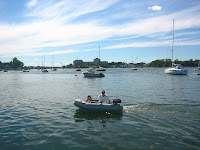



After stepping the mast and rigging the boat we were in around 10. Got the sails on, messed around with the motor and we were gone around noon. Despite a couple of hiccups it was the smoothest year I can remember.
The weather was perfect. There was a nice SE wind pushing us along gently at 5/6 knots or so. Maya had a great time. She did some needed bonding with "Tio Carlosi", took a quick nap and had her sea legs right away.


She did a few laps around the boat by herself, which is new for her. Even doing about 5 knots with a little heel to the boat she was really comfortable.


Her walk around the boat would have been even better if my hat didn't keep falling over her eyes but she had to wear the hat because there was no sunscreen on board yet.
After getting to PYC, she wanted to get off the boat and right into the dingy.

Her grandfather, "Ba" took her for a short cruise around the dinghy dock and Maya was happy to pass by Cicada on the way.



I decided that every year she gets to play hookey if Bumps and Bruises is getting launched, (or Jack-A-Roe, Cicada.....) She'll really be able to help out soon and before we know it will be taping the boots on the spreaders, tying the sheets on the jib, filling the dinghy, climbing up to get the lazy jacks unstuck etc.

...and in keeping with the battle of land or sea: Following her full day of sailing in the hot sun, the kid was promptly picked up by mom at the PYC docks and driven straight to a climbing gym. Needles to say the kid slept great that night.

No comments:
Post a Comment